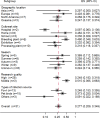Global prevalence of psittacosis in outbreaks: a systematic review and meta-analysis
- PMID: 40450215
- PMCID: PMC12125822
- DOI: 10.1186/s12889-025-21612-y
Global prevalence of psittacosis in outbreaks: a systematic review and meta-analysis
Abstract
Background: Psittacosis is a globally underappreciated and frequently undiagnosed zoonotic disease, and it is often difficult to determine the number of individuals exposed to Chlamydia psittaci. Despite numerous reported cases and outbreaks worldwide, there has been no systematic assessment of psittacosis prevalence to date, which is crucial for evaluating the disease burden and developing vaccines. Our objective is to evaluate the global prevalence of psittacosis in outbreaks.
Methods: We conducted a comprehensive search across multiple databases, including PubMed, Web of Science, Cochrane Library, and Medline, from the date of establishment to May 15, 2024. Additionally, we manually searched reference lists of included articles and retrieved reviews to identify any supplementary articles. The primary summary data was the prevalence of psittacosis in the outbreaks. Pooled estimates of prevalence were calculated for both the entire population and subgroups using a random-effects model.
Results: Thirty-one eligible studies from 13 countries across four continents were included in this review. The pooled prevalence of psittacosis among 4,158 exposed individuals in outbreaks was 27.7% (95% CI: 20.9-34.9). Meta-regression analysis of six potential influencing factors (geographic region, outbreak sites, outbreak season, infectious source, publication year, and study quality) indicated that the source of heterogeneity may be associated with the outbreak sites (P = 0.031). Furthermore, among the cases collected, the hospitalization rate was 42.3% (95% CI: 24.7-60.8), the prevalence of pneumonia was 59.7% (95% CI: 41.4-76.9), and the fatality rate was 1.8% (95% CI: 0-6.9).
Conclusions: The global prevalence of psittacosis in outbreaks was found to be 27.7%, with a hospitalization rate of 42.3%, a pneumonia rate of 59.7%, and a mortality rate of 1.8%. Such knowledge will assist governmental and medical authorities in formulating public health policies for populations at high risk of bird exposure, assessing the disease burden, and developing effective vaccines.
Keywords: Chlamydia psittaci; Meta-analysis; Outbreaks; Prevalence; Psittacosis.
© 2025. The Author(s).
Conflict of interest statement
Declarations. Ethics approval and consent to participate: Not applicable. Consent for publication: Not applicable. Competing interests: The authors declare no competing interests.
Figures




Similar articles
-
Laboratory methods for case finding in human psittacosis outbreaks: a systematic review.BMC Infect Dis. 2018 Aug 30;18(1):442. doi: 10.1186/s12879-018-3317-0. BMC Infect Dis. 2018. PMID: 30165831 Free PMC article.
-
Prenatal administration of progestogens for preventing spontaneous preterm birth in women with a multiple pregnancy.Cochrane Database Syst Rev. 2019 Nov 20;2019(11):CD012024. doi: 10.1002/14651858.CD012024.pub3. Cochrane Database Syst Rev. 2019. PMID: 31745984 Free PMC article.
-
Pharmacological and electronic cigarette interventions for smoking cessation in adults: component network meta-analyses.Cochrane Database Syst Rev. 2023 Sep 12;9(9):CD015226. doi: 10.1002/14651858.CD015226.pub2. Cochrane Database Syst Rev. 2023. PMID: 37696529 Free PMC article.
-
Chlamydia psittaci (psittacosis) as a cause of community-acquired pneumonia: a systematic review and meta-analysis.Epidemiol Infect. 2017 Nov;145(15):3096-3105. doi: 10.1017/S0950268817002060. Epub 2017 Sep 26. Epidemiol Infect. 2017. PMID: 28946931 Free PMC article.
-
Global, regional and national trends in the burden of persistent pulmonary hypertension of the newborn and essentials of its management from 1993 to 2023: a scoping review.Front Pediatr. 2025 Jun 4;13:1502385. doi: 10.3389/fped.2025.1502385. eCollection 2025. Front Pediatr. 2025. PMID: 40535701 Free PMC article. Review.
Cited by
-
Clinical characteristics of Chlamydia psittaci pneumonia: a single-center, retrospective study over 5 years.BMC Infect Dis. 2025 Aug 16;25(1):1027. doi: 10.1186/s12879-025-11450-z. BMC Infect Dis. 2025. PMID: 40819069 Free PMC article.
References
-
- Ramsay EC. The psittacosis outbreak of 1929–1930. J Avian Med Surg. 2003;17(4):235–7.
-
- Sukon P, Nam NH, Kittipreeya P, Sara-In A, Wawilai P, Inchuai R, et al. Global prevalence of chlamydial infections in birds: a systematic review and meta-analysis. Prev Vet Med. 2021;192:105370. 10.1016/j.prevetmed.2021.105370. - PubMed
Publication types
MeSH terms
Grants and funding
LinkOut - more resources
Full Text Sources
Medical

